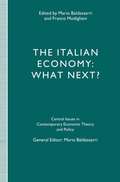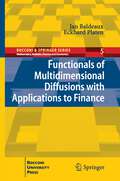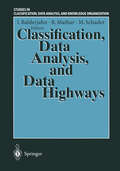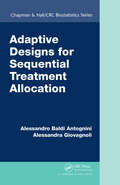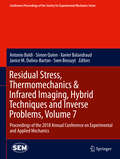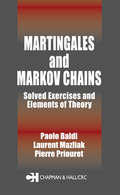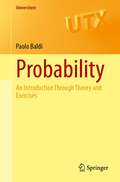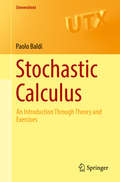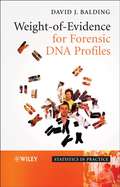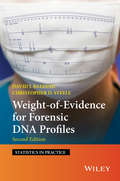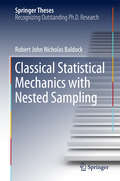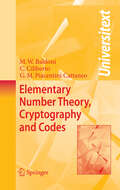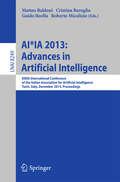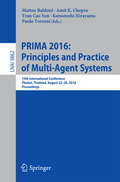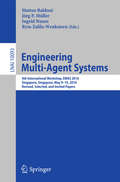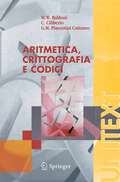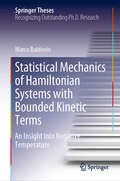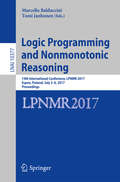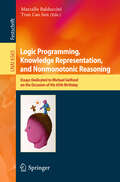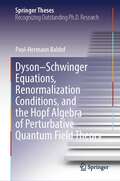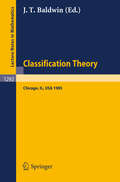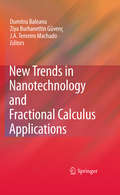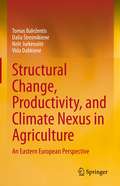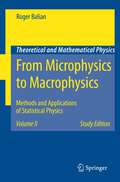- Table View
- List View
The Italian Economy: What Next? (Central Issues in Contemporary Economic Theory and Policy)
by Mario Baldassarri Franco ModiglianiSince the early 1970s the Italian economy has been moving towards an irreversible real and financial crisis. Paradoxically, the conditions engendered by the currency crisis and recession may also provide the basis for a new economic policy strategy, which could lead to built a mere 'economic miracle!'
Functionals of Multidimensional Diffusions with Applications to Finance (Bocconi & Springer Series #5)
by Jan Baldeaux Eckhard PlatenThis research monograph provides an introduction to tractable multidimensional diffusion models, where transition densities, Laplace transforms, Fourier transforms, fundamental solutions or functionals can be obtained in explicit form. The book also provides an introduction to the use of Lie symmetry group methods for diffusions, which allows to compute a wide range of functionals. Besides the well-known methodology on affine diffusions it presents a novel approach to affine processes with applications in finance. Numerical methods, including Monte Carlo and quadrature methods, are discussed together with supporting material on stochastic processes. Applications in finance, for instance, on credit risk and credit valuation adjustment are included in the book. The functionals of multidimensional diffusions analyzed in this book are significant for many areas of application beyond finance. The book is aimed at a wide readership, and develops an intuitive and rigorous understanding of the mathematics underlying the derivation of explicit formulas for functionals of multidimensional diffusions.
Classification, Data Analysis, and Data Highways: Proceedings of the 21st Annual Conference of the Gesellschaft für Klassifikation e.V., University of Potsdam, March 12–14, 1997 (Studies in Classification, Data Analysis, and Knowledge Organization)
by Ingo Balderjahn Rudolf Mathar Martin SchaderAdaptive Designs for Sequential Treatment Allocation
by Alessandro Baldi Antognini Alessandra GiovagnoliAdaptive Designs for Sequential Treatment Allocation presents a rigorous theoretical treatment of the results and mathematical foundation of adaptive design theory. The book focuses on designing sequential randomized experiments to compare two or more treatments incorporating information accrued along the way. The authors first introduce the termin
Residual Stress, Thermomechanics & Infrared Imaging, Hybrid Techniques and Inverse Problems, Volume 7: Proceedings of the 2018 Annual Conference on Experimental and Applied Mechanics (Conference Proceedings of the Society for Experimental Mechanics Series)
by Antonio Baldi Simon Quinn Xavier Balandraud Janice M. Dulieu-Barton Sven BossuytResidual Stress, Thermomechanics & Infrared Imaging, Hybrid Techniques and Inverse Problems, Volume 7 of the Proceedings of the 2018 SEM Annual Conference & Exposition on Experimental and Applied Mechanics, the seventh volume of eight from the Conference, brings together contributions to this important area of research and engineering. The collection presents early findings and case studies on a wide range of areas, including: Inverse Problems/Hybrid TechniquesMaterial Characterizations Using ThermographyThermoelastic Stress AnalysisFatigue & Damage Evaluation Using Infrared ThermographyIntegration of Infrared Thermography & DICThermographic Non-Destructive Evaluation (NDE)
Martingales and Markov Chains: Solved Exercises and Elements of Theory
by Paolo BaldiA thorough grounding in Markov chains and martingales is essential in dealing with many problems in applied probability, and is a gateway to the more complex situations encountered in the study of stochastic processes. Exercises are a fundamental and valuable training tool that deepen students' understanding of theoretical principles and prepare th
Probability: An Introduction Through Theory and Exercises (Universitext)
by Paolo BaldiThis textbook offers a complete one-semester course in probability, covering the essential topics necessary for further study in the areas of probability and statistics. The book begins with a review of the fundamentals of measure theory and integration. Probability measures, random variables, and their laws are introduced next, along with the main analytic tools for their investigation, accompanied by some applications to statistics. Questions of convergence lead to classical results such as the law of large numbers and the central limit theorem with their applications also to statistical analysis and more. Conditioning is the next main topic, followed by a thorough introduction to discrete time martingales. Some attention is given to computer simulation. Through the text, over 150 exercises with full solutions not only reinforce the concepts presented, but also provide students with opportunities to develop their problem-solving skills, and make this textbook suitable for guided self-study. Based on years of teaching experience, the author's expertise will be evident in the clear presentation of material and the carefully chosen exercises. Assuming familiarity with measure and integration theory as well as elementary notions of probability, the book is specifically designed for teaching in parallel with a first course in measure theory. An invaluable resource for both instructors and students alike, it offers ideal preparation for further courses in statistics or probability, such as stochastic calculus, as covered in the author's book on the topic.
Stochastic Calculus: An Introduction Through Theory and Exercises (Universitext)
by Paolo BaldiThis book provides a comprehensive introduction to the theory of stochastic calculus and some of its applications. It is the only textbook on the subject to include more than two hundred exercises with complete solutions.After explaining the basic elements of probability, the author introduces more advanced topics such as Brownian motion, martingales and Markov processes. The core of the book covers stochastic calculus, including stochastic differential equations, the relationship to partial differential equations, numerical methods and simulation, as well as applications of stochastic processes to finance. The final chapter provides detailed solutions to all exercises, in some cases presenting various solution techniques together with a discussion of advantages and drawbacks of the methods used. Stochastic Calculus will be particularly useful to advanced undergraduate and graduate students wishing to acquire a solid understanding of the subject through the theory and exercises. Including full mathematical statements and rigorous proofs, this book is completely self-contained and suitable for lecture courses as well as self-study.
Weight-of-Evidence for Forensic DNA Profiles (Statistics in Practice)
by David J. BaldingAssessing Weight-of-Evidence for DNA Profiles is an excellent introductory text to the use of statistical analysis for assessing DNA evidence. It offers practical guidance to forensic scientists with little dependence on mathematical ability as the book includes background information on statistics – including likelihood ratios – population genetics, and courtroom issues. The author, who is highly experienced in this field, has illustrated the book throughout with his own experiences as well as providing a theoretical underpinning to the subject. It is an ideal choice for forensic scientists and lawyers, as well as statisticians and population geneticists with an interest in forensic science and DNA.
Weight-of-Evidence for Forensic DNA Profiles (Statistics in Practice #34)
by David J. Balding Christopher D. SteeleDNA evidence is widely used in the modern justice system. Statistical methodology plays a key role in ensuring that this evidence is collected, interpreted, analysed and presented correctly. This book is a guide to assessing DNA evidence and presenting that evidence in a courtroom setting. It offers practical guidance to forensic scientists with little dependence on mathematical ability, and provides the scientist with the understanding they require to apply the methods in their work. Since the publication of the first edition of this book in 2005 there have been many incremental changes, and one dramatic change which is the emergence of low template DNA (LTDNA) profiles. This second edition is edited and expanded to cover the basics of LTDNA technology. The author's own open-source R code likeLTD is described and used for worked examples in the book. Commercial and free software are also covered.
Weight-of-Evidence for Forensic DNA Profiles (Statistics in Practice)
by David J. Balding Christopher D. SteeleDNA evidence is widely used in the modern justice system. Statistical methodology plays a key role in ensuring that this evidence is collected, interpreted, analysed and presented correctly. This book is a guide to assessing DNA evidence and presenting that evidence in a courtroom setting. It offers practical guidance to forensic scientists with little dependence on mathematical ability, and provides the scientist with the understanding they require to apply the methods in their work. Since the publication of the first edition of this book in 2005 there have been many incremental changes, and one dramatic change which is the emergence of low template DNA (LTDNA) profiles. This second edition is edited and expanded to cover the basics of LTDNA technology. The author's own open-source R code likeLTD is described and used for worked examples in the book. Commercial and free software are also covered.
Classical Statistical Mechanics with Nested Sampling (Springer Theses)
by Robert John BaldockThis thesis develops a nested sampling algorithm into a black box tool for directly calculating the partition function, and thus the complete phase diagram of a material, from the interatomic potential energy function. It represents a significant step forward in our ability to accurately describe the finite temperature properties of materials. In principle, the macroscopic phases of matter are related to the microscopic interactions of atoms by statistical mechanics and the partition function. In practice, direct calculation of the partition function has proved infeasible for realistic models of atomic interactions, even with modern atomistic simulation methods. The thesis also shows how the output of nested sampling calculations can be processed to calculate the complete PVT (pressure–volume–temperature) equation of state for a material, and applies the nested sampling algorithm to calculate the pressure–temperature phase diagrams of aluminium and a model binary alloy.
Elementary Number Theory, Cryptography and Codes (Universitext)
by M. Welleda Baldoni Ciro Ciliberto G.M. Piacentini CattaneoIn this volume one finds basic techniques from algebra and number theory (e.g. congruences, unique factorization domains, finite fields, quadratic residues, primality tests, continued fractions, etc.) which in recent years have proven to be extremely useful for applications to cryptography and coding theory. Both cryptography and codes have crucial applications in our daily lives, and they are described here, while the complexity problems that arise in implementing the related numerical algorithms are also taken into due account. Cryptography has been developed in great detail, both in its classical and more recent aspects. In particular public key cryptography is extensively discussed, the use of algebraic geometry, specifically of elliptic curves over finite fields, is illustrated, and a final chapter is devoted to quantum cryptography, which is the new frontier of the field. Coding theory is not discussed in full; however a chapter, sufficient for a good introduction to the subject, has been devoted to linear codes. Each chapter ends with several complements and with an extensive list of exercises, the solutions to most of which are included in the last chapter. Though the book contains advanced material, such as cryptography on elliptic curves, Goppa codes using algebraic curves over finite fields, and the recent AKS polynomial primality test, the authors' objective has been to keep the exposition as self-contained and elementary as possible. Therefore the book will be useful to students and researchers, both in theoretical (e.g. mathematicians) and in applied sciences (e.g. physicists, engineers, computer scientists, etc.) seeking a friendly introduction to the important subjects treated here. The book will also be useful for teachers who intend to give courses on these topics.
AI*IA 2013: XIIIth International Conference of the Italian Association for Artificial Intelligence, Turin, Italy, December 4-6, 2013, Proceedings (Lecture Notes in Computer Science #8249)
by Matteo Baldoni Cristina Baroglio Guido Boella Roberto MicalizioThis book constitutes the refereed proceedings of the 13th International Conference of the Italian Association for Artificial Intelligence, AI*IA 2013, held in Turin, Italy, in December 2013. The 45 revised full papers were carefully reviewed and selected from 86 submissions. The conference covers broadly the many aspects of theoretical and applied Artificial Intelligence as follows: knowledge representation and reasoning, machine learning, natural language processing, planning, distributed AI: robotics and MAS, recommender systems and semantic Web and AI applications.
PRIMA 2016: 19th International Conference, Phuket, Thailand, August 22-26, 2016, Proceedings (Lecture Notes in Computer Science #9862)
by Matteo Baldoni Amit K. Chopra Tran Cao Son Katsutoshi Hirayama Paolo TorroniThis book constitutes the refereed proceedings of the 19th International Conference on Principles and Practice of Multi-Agent Systems, PRIMA 2016, held in Phuket, Thailand, in August 22-26, 2016. The 16 revised full papers presented together with two invited papers, 9 short papers and three extended abstracts were carefully reviewed and selected from 50 submissions. The intention of the papers is to showcase research in several domains, ranging from foundations of agent theory and engineering aspects of agent systems, to emerging interdisciplinary areas of agent-based research.
Engineering Multi-Agent Systems: 4th International Workshop, EMAS 2016, Singapore, Singapore, May 9-10, 2016, Revised, Selected, and Invited Papers (Lecture Notes in Computer Science #10093)
by Matteo Baldoni Jörg P. Müller Ingrid Nunes Rym Zalila-WenksternThis book constitutes revised, selected, and invited papers from the 4th International Workshop on Engineering Multi-Agent Systems, EMAS 2016, held in Singapore, in May 2016, in conjunction with AAMAS. The 10 full papers presented in this volume were carefully reviewed and selected from 14 submissions. The book also contains 2 invited papers; extended versions of AAMAS 2016 demonstration abstracts. EMAS deals with MAS software engineering processes, methodologies and techniques; Programming languages for MAS; Formal methods and declarative technologies for the specification, validation and verification of MAS; and development tools.
Aritmetica, crittografia e codici (UNITEXT)
by W.M. Baldoni C. Ciliberto G.M. Piacentini CattaneoIl volume potrà essere utile ai docenti che intendano svolgere un corso su questi argomenti, la cui presenza sempre più viene richiesta nei corsi di laurea di matematica, fisica, informatica, ingnegneria.
Statistical Mechanics of Hamiltonian Systems with Bounded Kinetic Terms: An Insight into Negative Temperature (Springer Theses)
by Marco BaldovinRecent experimental evidence about the possibility of "absolute negative temperature" states in physical systems has triggered a stimulating debate about the consistency of such a concept from the point of view of Statistical Mechanics. It is not clear whether the usual results of this field can be safely extended to negative-temperature states; some authors even propose fundamental modifications to the Statistical Mechanics formalism, starting with the very definition of entropy, in order to avoid the occurrence of negative values of the temperature tout-court.The research presented in this thesis aims to shed some light on this controversial topic. To this end, a particular class of Hamiltonian systems with bounded kinetic terms, which can assume negative temperature, is extensively studied, both analytically and numerically. Equilibrium and out-of-equilibrium properties of this kind of system are investigated, reinforcing the overall picture that the introduction of negative temperature does not lead to any contradiction or paradox.
Logic Programming and Nonmonotonic Reasoning: 14th International Conference, LPNMR 2017, Espoo, Finland, July 3-6, 2017, Proceedings (Lecture Notes in Computer Science #10377)
by Marcello Balduccini Tomi JanhunenThis book constitutes the refereed proceedings of the 14th International Conference on Logic Programming and Nonmonotonic Reasoning, LPNMR 2017, held in Espoo, Finland, in July 2017. The 16 full papers and 11 short papers presented in this volume were carefully reviewed and selected from 47 submissions. The book also contains 4 invited talks. The papers were organized in topical sections named: nonmonotonic reasoning; answer set programming; LPNMR systems; and LPNMR applications.
Logic Programming, Knowledge Representation, and Nonmonotonic Reasoning: Essays Dedicated to Michael Gelfond on the Occasion of His 65th Birthday (Lecture Notes in Computer Science #6565)
by Marcello Balduccini Tran Cao SonThis Festschrift volume, published in honor of Michael Gelfond on the occasion of his 65th birthday, contains a collection of papers written by his closest friends and colleagues. Several of these papers were presented during the Symposium on Constructive Mathematics in Computer Science, held in Lexington, KY, USA on October 25-26, 2010. The 27 scientific papers included in the book focus on answer set programming. The papers are organized in sections named “Foundations: ASP and Theories of LP, KR, and NMR”, “ASP and Dynamic Domains”, and “ASP – Applications and Tools”.
Dyson–Schwinger Equations, Renormalization Conditions, and the Hopf Algebra of Perturbative Quantum Field Theory (Springer Theses)
by Paul-Hermann BaldufThis book offers a systematic introduction to the Hopf algebra of renormalization in quantum field theory, with a special focus on physical motivation, the role of Dyson–Schwinger equations, and the renormalization group. All necessary physical and mathematical constructions are reviewed and motivated in a self-contained introduction. The main part of the book concerns the interplay between Dyson–Schwinger equations (DSEs) and renormalization conditions. The book is explicit and consistent about whether a statement is true in general or only in particular renormalization schemes or approximations and about the dependence of quantities on regularization parameters or coupling constants. With over 600 references, the original literature is cited whenever possible and the book contains numerous references to other works discussing further details, generalizations, or alternative approaches. There are explicit examples and remarks to make the connection from the scalar fields at hand toQED and QCD. The book is primarily targeted at the mathematically oriented physicist who seeks a systematic conceptual overview of renormalization, Hopf algebra, and DSEs. These may be graduate students entering the field as well as practitioners seeking a self-contained account of the Hopf algebra construction. Conversely, the book also benefits the mathematician who is interested in the physical background of the exciting interplay between Hopf algebra, combinatorics and physics that is renormalization theory today.
Classification Theory: Proceedings of the U.S.-Israel Workshop on Model Theory in Mathematical Logic Held in Chicago, Dec. 15-19, 1985 (Lecture Notes in Mathematics #1292)
by John T. BaldwinNew Trends in Nanotechnology and Fractional Calculus Applications
by Dumitru Baleanu Ziya B. Guvenc J. A. Tenreiro MachadoIn recent years fractional calculus has played an important role in various fields such as mechanics, electricity, chemistry, biology, economics, modeling, identification, control theory and signal processing. The scope of this book is to present the state of the art in the study of fractional systems and the application of fractional differentiation. Furthermore, the manufacture of nanowires is important for the design of nanosensors and the development of high-yield thin films is vital in procuring clean solar energy. This wide range of applications is of interest to engineers, physicists and mathematicians.
Structural Change, Productivity, and Climate Nexus in Agriculture: An Eastern European Perspective
by Tomas Baležentis Dalia Štreimikienė Nelė Jurkėnaitė Vida DabkienėThis monograph addresses the methodological and empirical issues relevant for the development of sustainable agriculture, with a particular focus on Eastern Europe. It relates economic growth to the other dimensions of sustainability by applying integrated methods. The book comprises five chapters dedicated to the theoretical approaches towards sustainable rural development, productivity analysis, structural change analysis and environmental footprint. The book focuses on the transformations of the agricultural sector while taking into account economic, environmental, and social dynamics. The importance of agricultural transformations to the livelihood of the rural population and food security are highlighted. Further, advanced methodologies and frameworks are presented to fathom the underlying trends in different facets of agricultural production. The authors present statistical methods used for the analysis of agricultural sustainability along with applications for agriculture in the European Union. Additionally, they discuss the measures of efficiency, methodological approaches and empirical models. Finally, the book applies econometric and optimization techniques, which are useful for the estimation of the production functions and other representations of technology in the case of the European Union member states. Therefore, the book is a must-read for researchers and students of agricultural and production economics, as well as policy-makers and academia in general.
From Microphysics to Macrophysics: Methods and Applications of Statistical Physics. Volume II (Theoretical and Mathematical Physics)
by Roger BalianThis popular, often cited text returns in a softcover edition to provide a thorough introduction to statistical physics and thermodynamics, and to exhibit the universal chain of ideas leading from the laws of microphysics to the macroscopic behaviour of matter. A wide range of applications illustrates the concepts, and many exercises reinforce understanding. Volume II applies statistical methods to systems governed by quantum effects, in particular to solid state physics, explaining properties due to the crystal structure or to the lattice excitations or to the electrons. The last chapters are devoted to non-equilibrium processes and to kinetic equations, with many applications included.
